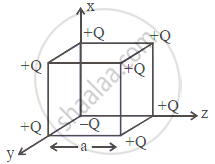Advertisements
Advertisements
Question
A cube of side 'a' has point charges +Q located at each of its vertices except at the origin where the charge is -Q. The electric field at the centre of cube is ______.

Options
`(2"Q")/(3sqrt3piepsilon_0a^2) (hatx +hat"y" +hat"z")`
`"Q"/(3sqrt3piepsilon_0a^2) (hatx +hat"y" +hat"z")`
`(-2"Q")/(3sqrt3piepsilon_0a^2) (hatx +hat"y" +hat"z")`
`(-"Q")/(3sqrt3piepsilon_0a^2) (hatx +hat"y" +hat"z")`
Solution
A cube of side 'a' has point charges +Q located at each of its vertices except at the origin where the charge is -Q. The electric field at the centre of cube is `bb((-2"Q")/(3sqrt3piepsilon_0a^2) (hatx +hat"y" +hat"z"))`.
Explanation:
We can swap out the -Q charge at the problem's genesis for +Q and -2Q to simplify the issue.
The electric field created by the corners +Q charge at the cube's centre will now be zero.
As a result, the -2Q charge of the origin's net electric field in the centre will function.
`vec"E"= ("kq" vec"r")/r^3 = (1(-2"Q")a/2(hatx+haty+hatz))/(4piepsilon_0(a/2sqrt3)^3)`
`vec"E" = (-2"Q"(hatx+haty+hatz))/(3sqrt3pia^2epsilon_0)`
